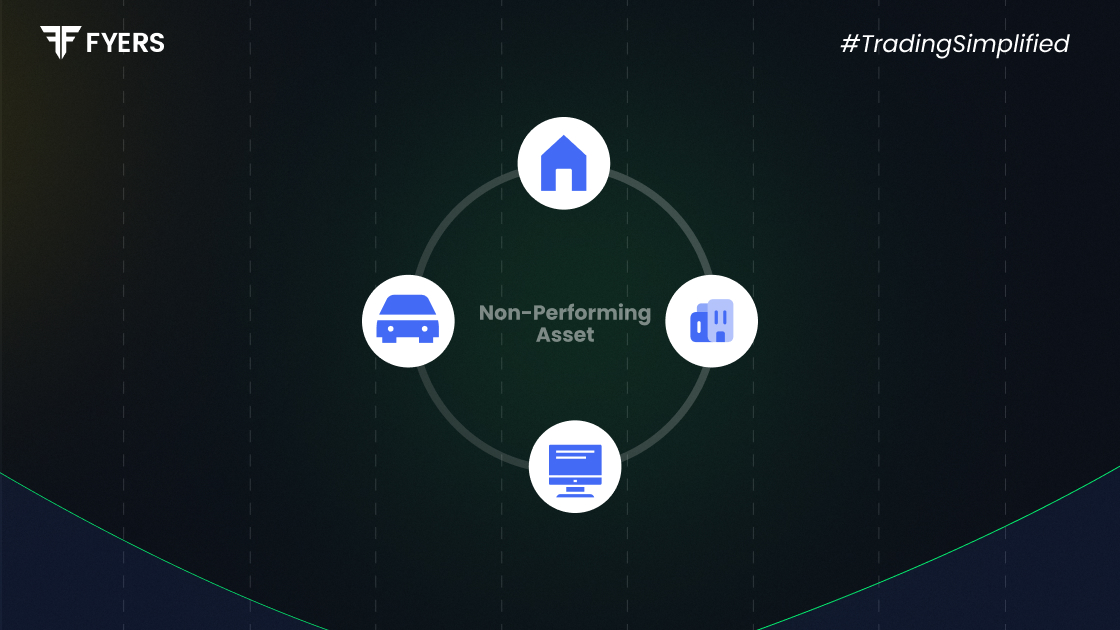

 16 Jul, 2025
16 Jul, 2025
 4 mins read
4 mins read

In the world of banking and finance, Non-Performing Assets (NPAs) are a red flag. They indicate loans where borrowers have stopped making repayments, which can seriously affect a bank’s financial health. A high level of NPAs impacts profitability, lending capacity, and even investor confidence.
In this blog, we’ll explain what is NPA, its types, classification, how NPAs work, and how India is addressing the NPA crisis.
A Non-Performing Asset (NPA) is a loan or advance for which the borrower has not paid interest or principal for more than 90 days. Once a loan remains overdue beyond this period, it is marked as an NPA on the bank’s balance sheet.
In simple terms, if you borrow money and stop paying EMIs for three months, your loan becomes a non-performing asset for the lender.
Here’s how a regular loan turns into a non-performing asset:
Loan Disbursal: The bank lends money to a borrower.
Repayment Schedule: The borrower agrees to repay via EMIs.
Default Begins: Missed payments for more than 90 days.
NPA Classification: The bank labels it as an NPA.
Provisioning: The bank sets aside funds for potential losses.
NPAs reduce interest income and increase credit risk, pushing banks to be more conservative in their lending.
According to the Reserve Bank of India (RBI), NPAs are classified based on the duration of non-repayment:
1. Substandard Assets
Remain NPA for ≤ 12 months
Risk of loss is moderate
Potential for partial recovery still exists
2. Doubtful Assets
Remain substandard for > 12 months
Higher risk, recovery is uncertain
Require higher provisioning by banks
3. Loss Assets
Considered non-recoverable
Identified by auditors or RBI
Written off even if legal recovery is still ongoing
This NPA classification helps banks apply the right provisioning rules and better understand the health of their loan portfolio.
Banks assess their asset quality using Gross and Net NPA Ratios:
NPA Ratio Formula
| Gross NPA Ratio = (Gross NPAs ÷ Gross Advances) × 100 |
Gross NPA: Total outstanding NPAs before provisions
Net NPA: Gross NPAs minus provisions
Example:
Gross Advances = ₹1,000 crore
Gross NPAs = ₹80 crore
Gross NPA Ratio = (80 ÷ 1,000) × 100 = 8%
This means 8% of the bank’s loans are non-performing, which is a key metric for investors and regulators.
Let’s say a small business takes a loan of ₹20 lakh to expand operations. It’s required to repay in EMIs over five years. However, due to financial challenges, it misses payments for four consecutive months.
After 90 days, the loan becomes an NPA
The bank must classify and provision for the expected loss
Depending on how long the default continues, the NPA may move from substandard to doubtful, or even loss asset
India has faced high NPA levels, especially post-2014 due to stressed sectors like infrastructure, real estate, and power. To combat this, several initiatives were launched:
IBC (Insolvency and Bankruptcy Code) for faster resolution
SARFAESI Act for secured asset recovery
Bad Bank setup (NARCL) to buy and clean bad loans from bank books
Debt Recovery Tribunals (DRTs) for legal enforcement
Banks in India use a variety of mechanisms to recover NPAs:
Loan restructuring or rescheduling
Asset sale to ARCs (Asset Reconstruction Companies)
SARFAESI Act enforcement
Insolvency proceedings under IBC
Out-of-court settlements or one-time settlements (OTS)
Non-Performing Assets (NPAs) are a critical measure of a bank’s asset quality and financial strength. They represent loans that aren’t generating income and may never be repaid. By understanding how NPAs work, their types, and how they’re managed, stakeholders can better judge a bank’s performance and the soundness of the financial system.
India continues to tackle the NPA problem with regulatory reforms, but proactive credit appraisal, effective monitoring, and faster resolution remain key.
It’s a loan where the borrower hasn’t paid interest or principal for over 90 days.
NPA stands for Non-Performing Asset.
Substandard: Overdue ≤ 12 months
Doubtful: Overdue > 12 months
Loss: Declared unrecoverable
Recovery tools include:
SARFAESI Act
IBC process
Sale to ARCs
Debt Recovery Tribunals
Launched Bad Bank (NARCL)
Strengthened IBC
Enforced RBI guidelines
Promoted early resolution mechanisms
Calculate your Net P&L after deducting all the charges like Tax, Brokerage, etc.
Find your required margin.
Calculate the average price you paid for a stock and determine your total cost.
Estimate your investment growth. Calculate potential returns on one-time investments.
Forecast your investment returns. Understand potential growth with regular contributions.